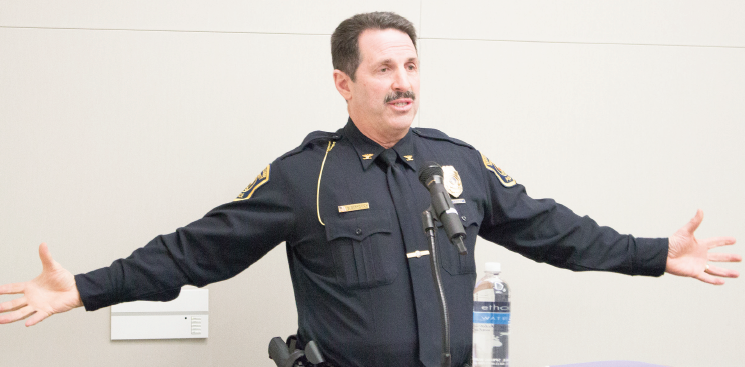
and faculty. Photo by: Keith Salowich | Editor in Chief
Since the infamous Columbine shooting on April 20, 1999, there have been 270 school shootings of various kinds.
Eighty-one percent of these shootings reported people having knowledge of a potential attack, 73 percent of the shooters had no prior record and 96 percent of the shooters were male.
On Feb. 15, Department of Public Safety Director Bruce Borkovich led a seminar at the University Center detailing what exactly Ferris’ plans are in the case of an emergency.
“This is not a drill. There is an active shooter in FLITE Library. Shelter in place.”
Minus the library part, these are the words every student, staff, faculty member and campus security official would hear in the event of a gunman on campus.
“One of my goals when I got here was to continuously increase the tactical abilities of our police officers,” said Borkovich. “Members of the department asked, ‘What do you expect from us?’ and I said it very clearly: ‘I expect you guys to treat people kindly and respectfully, to care for them and to protect this place, to serve, and then when the monster shows up, I expect you all to become Navy Seals. That’s all.’”
Borkovich then went on to detail how the team has been using abandoned buildings around campus, including the since demolished Helen Ferris Hall, to practice various entry techniques and defense tactics.
In the past, the general approach to active shooter situations across the board has been to set up a perimeter and then, after evaluation, plan a means of entry. This is not the case anymore, though.
“They are going in with a plan to shoot as many people as they can,” said Borkovich. “So the philosophy has changed. Now, among law enforcement, it is the plan that we are going to run to the gun fight.”
According to Borkovich, they already know what the shooter is thinking before they arrive on the scene.
“They know the police are coming and, as a general rule, they are planning on one of two things,” said Borkovich. “Either they are going to commit suicide or they are getting ready for a gun fight with the police.”
It is widely said that one of the biggest issues with active shooter situations is people not knowing what to do. Above, the term “shelter in place” was used, and what that essentially means is to find a secure place nearby to lock and barricade into. That isn’t always the best course of action, though.
“It’s like on airplanes, if you don’t hear the safety protocol you don’t know what to do and it’s going to take you longer to get off the plane,” said Ferris chemistry sophomore Kelsey Diamond. “I think it’s shied away from because it’s a scary topic, but it’s a very real topic and it’s something we need to talk about. It’s something that we simply cannot afford to avoid.”
Ferris social work senior Sam Baeten agreed with Diamond about the difficulties of a situation where there are so many different factors.
“It’s a topic that we’re not used to talking about,” said Baeten. “It’s not black-and-white like when there’s a fire. It can be in any situation anywhere and it helps having some background to know that this could happen, this is what you should do and what the emergency responders are going to do.”
One of the primary things Borkovich talked about with attendees was what they specifically should do in an emergency situation. This included things like the decision between running, hiding and fighting, but also how to interact with officials during or following an event.
“There’s a real danger if we have an active shooter and we’re trying to evacuate a building, the police don’t know who is who or how many people were involved,” said Borkovich. “We try to teach that when you come out, have your hands up and clear and listen to exactly what people are telling you. It’s possible that as you’re exiting, you might get handcuffed. That isn’t going to last very long, but they need to determine who you are and what is going on. It’s not the time to argue or debate, it’s the time to comply because the officers are doing the best they can.”
More information about emergency preparedness at Ferris can be found on the Department of Public Safety website at http://www.ferris.edu/htmls/othersrv/campussafety/emergency_preparedness.html.
